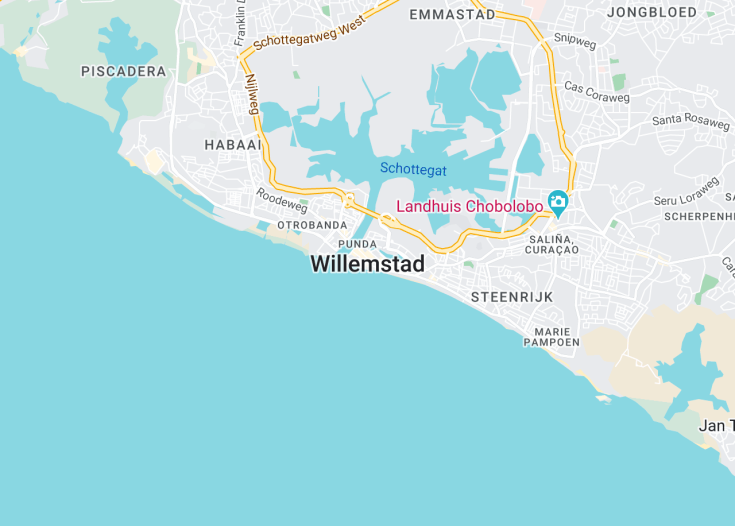Willemstad, the capital of Curaçao, stands as a vibrant and colorful gateway to the Caribbean, renowned for its historical and cultural significance. This UNESCO World Heritage site is famed for its iconic pastel-colored buildings and the bustling harbor entrance known as the “Handelskade”. Willemstad offers a unique blend of European architectural styles with Caribbean charm. Ancient forts, museums, and charming alleys add layers of historical depth, while the floating Queen Emma Bridge and nearby beaches offer a picturesque escape to nature and relaxation.
When visiting Willemstad, be sure to explore the Queen Emma Pontoon Bridge, also known as the “Swinging Old Lady”, a movable bridge that lights up beautifully at night.
Do take a walking tour through the historic Punda and Otrobanda neighborhoods to fully appreciate Willemstad’s rich blend of cultures and vivid colonial architecture.
Top things to do & see in Willemstad
Select the following sights and activities to discover best tickets and tours available in Willemstad.
Willemstad: Colorful Charm in the Caribbean
| Country | Curaçao (Netherlands) |
| Time in Willemstad | GMT-4 |
| Language spoken | Papiamento, Dutch |
| Population | 150,000 (World Population Review, 2023) |
| Currency | Netherlands Antillean guilder (ƒ, ANG) |
| Airports | Curaçao International Airport (4 mi / 6 km). |
Willemstad, the vibrant capital of Curaçao, is a UNESCO World Heritage site renowned for its historic architecture and bustling harbor. The city is the cultural and economic heart of the island, harmoniously blending Dutch colonial influences with Caribbean flair. The iconic Handelskade, a row of brightly colored Dutch-style buildings facing the harbor, is among the city’s most photographed features. Beyond its picturesque waterfront, Willemstad offers a plethora of cultural experiences, including museums, a dynamic arts scene, and diverse cuisine that mirrors its rich heritage.
Where is Willemstad?
Willemstad is located in the southern Caribbean, on the island of Curaçao, just north of Venezuela’s coast.
Distances:
| Route | Distance by car | Time by car |
|---|---|---|
| Curaçao Airport to Willemstad | 8 miles (13 km) | 15 min |
| Blue Bay to Willemstad | 6 miles (10 km) | 12 min |
| Jan Thiel to Willemstad | 5 miles (8 km) | 10 min |
What is Willemstad famous for?
Willemstad is famous for its well-preserved colonial architecture and vibrant, multicolored buildings that reflect both its historical significance and the island’s vivacious spirit. These features, alongside its floating Queen Emma Bridge and the lively floating market, draw visitors from around the world.
History
Pre-Colonial Era (Before 1499)
Willemstad’s story begins long before written records, originally inhabited by the Arawak people, particularly the Caiquetio tribe from the Arawak Indians. These indigenous inhabitants were primarily fishermen and lived a nomadic lifestyle on the island.
Spanish and Dutch Control (1499-1634)
The island of Curaçao was discovered by the Spanish in 1499. Alonso de Ojeda, a lieutenant of Christopher Columbus, was the first European to arrive. The Spanish laid claim but did not heavily colonize the island due to its perceived lack of gold and resources. It wasn’t until 1634 that the Dutch, recognizing the island’s strategic location for trade and salt mining, captured Curaçao from the Spanish, thus establishing Willemstad as a colonial outpost.
Dutch Colonial Expansion (1634-1795)
Dutch settlers started to build Fort Amsterdam in 1634, around which Willemstad began to develop. The natural harbour of St. Anna Bay was utilized to enhance mercantile trade, including the notorious transatlantic slave trade. Willemstad’s economy boomed, transforming it into a commercial hub. The city was official named as the capital of Curaçao in the 18th century.
British Invasion and Abolition Era (1800-1863)
The Napoleonic Wars in Europe had repercussions extending to Willemstad when the British briefly captured the island, influencing local architecture and trade. After multiple changes in control, it eventually returned to Dutch rule in 1815. In 1863, the Dutch abolished slavery, leading to significant social and economic changes in Willemstad.
Modernization and Today (1900s-Present)
In the 20th century, Willemstad witnessed substantial economic growth with the establishment of the oil refinery in 1918, which attracted international workers and boosted local industries. Today, Willemstad is recognized for its vibrant cultural heritage, historic architecture, and as a pivotal Caribbean hub for trade and tourism. It was designated a UNESCO World Heritage site in 1997, celebrating its well-preserved colonial architecture and multicultural roots.
Visit Willemstad
What to see and do in Willemstad, Curaçao (Netherlands)
Willemstad, the capital of Curaçao, offers a vibrant cultural and historical experience. Key attractions include:
- The brightly colored Handelskade waterfront, a defining image of the city.
- Queen Emma Bridge, a floating pedestrian bridge providing picturesque views.
- The historic area of Otrobanda, known for its winding streets and colonial buildings.
- Fort Amsterdam, serving as both a museum and the governor’s palace.
- The Curaçao Maritime Museum and Kura Hulanda Museum, which delve into the island’s rich maritime and cultural history.
These sites provide a deep dive into the heritage and scenic beauty of Willemstad.
Festivities and Celebrations in Willemstad
Willemstad hosts several events that reflect its multicultural heritage, notably:
The Curaçao Carnival, spanning several weeks in late January to early February, is a spectacular display of costumes, parades, and music. Another significant event is the Curaçao North Sea Jazz Festival, held in August, attracting international artists and audiences.
Best time to visit Willemstad
The best time to visit Willemstad is from May to November when the weather is most favorable, and the city is less crowded, allowing for a more enjoyable exploration of its historical and cultural landscapes.
Is Willemstad worth visiting?
Indeed, Willemstad is worth visiting for its enriching cultural tapestry, historical depth, and architectural beauty. The city offers a unique blend of Dutch colonial history intertwined with vibrant Caribbean energy, making it a captivating destination for travelers seeking both relaxation and educational pursuits.










